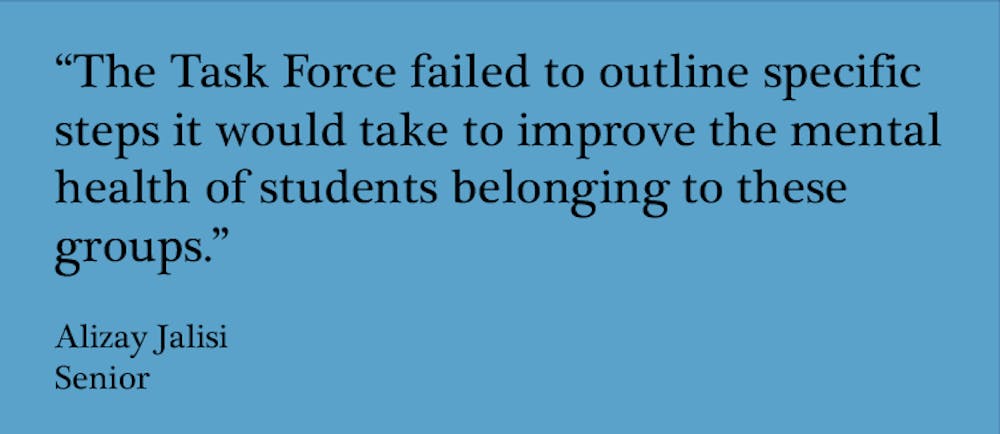On Feb. 22, 2018 the Task Force on Student Mental Health and Well-being released a report outlining the insufficiently met mental health needs of students and strategies to better meet those needs. Three major recommendations called on Hopkins to “promote a climate of awareness,” “to provide greater access to mental health services” and “offer, and in some cases require, training on mental health awareness and resources for faculty, staff, and students.”
The report mentions briefly that certain groups such as students exposed to violence; first-generation college students; students of color, especially black students; and queer students are more predisposed to suffer from mental illness.
Despite this recognition, the Task Force failed to outline specific steps it would take to improve the mental health of students belonging to these groups. With the help of other students from diverse backgrounds, I have drafted the following list of demands that should be part of immediate efforts to prioritize the health and wellness of students of color on campus.
Required trainings for faculty, students and staff
I believe that it should not just be recommended but in fact required that all faculty, staff and students attend annual trainings sponsored by Student Disability Services and the Counseling Center that are grounded in an intersectional focus on how race, gender, sexuality, religion, culture, physical ability and socioeconomic status impact the risk for particular conditions.
These trainings must also clearly address concrete ways to eliminate language that is ableist (like using the words “crazy,” “triggered” and “psycho” in inappropriate contexts) and ways to communicate with and support these students in a culturally-concordant manner if they happen to demonstrate symptoms of anxiety, depression and suicidal thoughts.
Accountability for everyone
I believe that there should be clear language embedded within the Codes of Conduct for students, faculty and staff prohibiting discrimination on the basis of psychological and psychiatric disorders, especially since students of color are more likely to be affected by such discrimination. Discrimination includes, for example, a professor refusing to give a student extra time on assignments despite receiving documentation of the student’s mental illness from a psychiatrist or psychologist.
Furthermore, I believe that an anonymous, centralized reporting system should be established through joint partnership between the Counseling Center, the Task Force on Mental Health and Well-being, Student Disability Services and the Office of Institutional Equity. Through this reporting system, students, faculty and staff can report instances of discrimination and seek justice.
Hiring more faculty and staff of color
White faculty and staff, while capable of being allies, are simply unable to experience the daily instances of racism that we face on and off campus. It is high time that the University hires more faculty and staff of color in all departments to serve as mentors, role models and support systems for students of color at this University. In the Counseling Center, such efforts are already being made, yet the needs of students of color are too high, too deep and too diverse for counselors alone to provide adequate care.
We should not have to resort to expensive, non-affiliated therapists and psychiatrists (who often end up being white). Students of color, especially black and Native American students, should never be feeling so anxious, depressed and isolated to the point at which it is difficult for them to function, succeed and blossom everyday here.
An on-campus student center
While the work that the Office of Multicultural Affairs (OMA), the Office of LGBTQ Life and Women and Gender Resources (WGR) do is incredible, they are off campus and not frequented by those who do not identify as minorities. Furthermore, even though student groups, teams and Greek Life provide empowering spaces for students of color, the burden must not be put on them alone to create a more inclusive community across the entire campus. The administration and students need to work together to create an on-campus center, with designated spaces for students of color, which would complement and further the work being done by these student organizations.
As I envision it, a student center would act as a centralized space to host Stressbusters sessions, eat pizza, have arts and crafts workshops and whatever else students like to do to relax and have fun in groups. The student center could also provide readily available, centralized resources in the form of advisors, brochures and workshops for students to maintain their health and wellness.
Such resources could provide information on how to register with Student Disability Services, how to report experiences with sexual assault, lists of services offered by the Counseling Center and more, since many students on campus currently report not being aware of the resources that Hopkins has to offer them. My hope is that through these efforts, a student center would foster a greater sense of community and therefore especially create a healthier atmosphere for students of color.
Jordan Britton ‘17, Bhavitha Kotha ‘18, Naadiya Hutchinson ‘19 and Ifeyinwa Egbunike ‘20 contributed to this list.
Alizay Jalisi is a senior Molecular & Cellular Biology and Spanish major from Baltimore, Md.





